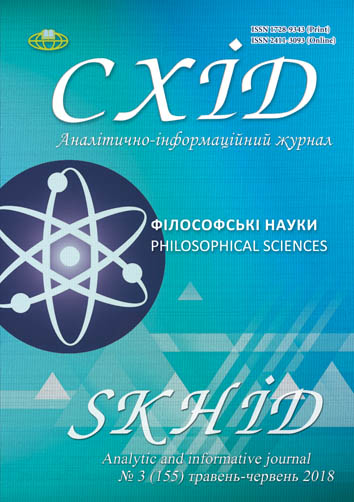The image of the Prophet Muhammad in the context of understanding Islam in Japan in the first half of the 20th century
DOI:
https://doi.org/10.21847/1728-9343.2018.3(155).139762Keywords:
Islam, Pan-Asianism, Pan-Islamism, Prophet Muhammad, Japanese translations of the QuranAbstract
The article is devoted to the analysis of the different variations of the image of the Prophet Muhammad and the elucidation of the features and understanding Islam in Japan in the first half of the 20th century. Islam is considered in the context of the religious, political and cultural environment. This religion makes attempts to synthesize Muslim teaching with Japanese religious traditions. On the other hand, Islam was applied for the development of pan-Asian ideology. The study of the perception of this religion in Japan will help understand the nature of the phenomenon that played a significant role in the development of the country at the turn of the century. As a result of the research have been established the features of the historical perception of Muhammad as a hero and the religious interpretation of the prophet as the founder and leader of Islam. Also, in this research have been found that the main feature of Islam is the tendency to syncretize various religious traditions - Shinto, Buddhism, and Confucianism with Muslim teaching. The article is showing how this understanding of Islam in Japan was formed and what factors influenced its development.Downloads
References
Lach, Donald F. 1965. Asia in the Making of Europe. In: The Century of Discovery. The University of Chicago Press, 543 p.
Krämer, Hans Martin. 2014. Pan-Asianism's Religious Undercurrents: The Reception of Islam and Translation of the Qur'ān in Twentieth Century Japan. The Journal of Asian Studies, p. 619-640. Available at: http://journals.cambridge.org/abstract_S0021911814000989
Aydin, Cemil. 2008. Japan's Pan-Asianism and the Legitimacy of Imperial World Order, 1931-1945. The Asia Pacific Journal. Vol. 6, Issue 3. Available at: http://apjjf.org/-Cemil-Aydin/2695/article.html
Kawamura, Mitsuro川村光郎. 1987. The pre-war history of Islam in the Near East戦前日本イスラム中東研究小史. The Japanese Association for the Study of the Near East日本中東学会, p. 409-439.
Nakamura, K. 2007. The Significance of Toshihiko Izutsu’s Legacy for Comparative Religion. Journal Intellectual Discourse, vol.17, № 2., p. 14-158.
Palme, Louis, 2010. Revisiting Thomas Carlyle and his Hero Muhammad. Annaqed (“The Critice”). Available at: http://www.annaqed.com/en/islam-under-the-microscope/revisiting-thomas-carlyle-and-his-hero-muhammad
Samir, A. Nouh. 2012. Muslims in Japanwith the comparison of those in Europe. Available at: http://web.cla.kobe-u.ac.jp/group/IReC/pdf/2012_nouh.pdf
Shimamoto, Takamitsu 嶋本隆光. 2008. Religious Studies by Okawa Shumei. Way to the Study of Islam. 大川周 明の 宗教研究 一 イス ラー ム 研究へ の 道一.Osaka University大阪大学, 22 p.
Tanhka, Brij, ed.. 2007. Okakura Tenshin and Pan-Asianism: Shadows of the Past.New Delhi: Sampark, 189 p.
Sarifu-Маhdy, Arusamarai 2009. The history of Islam in Japan日本のイスラーム歴史. Available at: http://islamcenter.or.jp/history-and-publications/history-of-islam-in-japan/
Albayrak, İsmail, and إسماعيل البيراك. 2012. The Reception of Toshihiko Izutsu's Qur’anic Studies in the Muslim World: With Special Reference to Turkish Qur'anic Scholarship / استقبال (الدراسات القرآنية) لتوشيهيكو إيزوﺗﺴﻮ في العالم الإسلامي مع تركيز خاص على الدراسات التركية للقرآن. Journal of Qur'anic Studies 14, no. 1: 73-106. Available at: //www.jstor.org/stable/41719816.
Downloads
Published
How to Cite
Issue
Section
License
Copyright (c) 2018 Oleksandra Bibik

This work is licensed under a Creative Commons Attribution-NonCommercial-NoDerivatives 4.0 International License.
1. Authors bear responsibility for the accuracy of facts, quotations, numbers and names used.
2. Manuscripts are not sent back.
3. The publisher does not always agree with the authors' opinion.
4. The authors reserve the right to authorship of the work and pass the first publication right of this work to the journal under the terms of a Creative Commons Attribution-NonCommercial-NoDerivatives 4.0 International License. This license allows others to distribute (copy) the published work for non-commercial purposes, provided there is mandatory attribution to its authors and a link to the first publication in our journal.
5. The authors have the right to conclude separate supplement agreements that relate to non-exclusive work distribution in the form in which it has been published by the journal (for example, to upload the work to the online storage of the journal or publish it as part of a monograph), provided that the reference to the first publication of the work in this journal is included.

